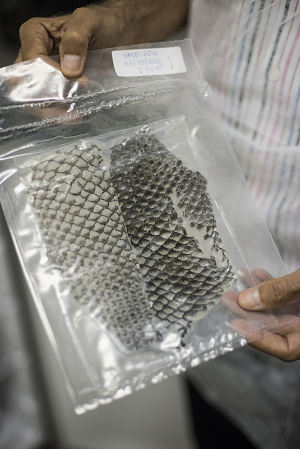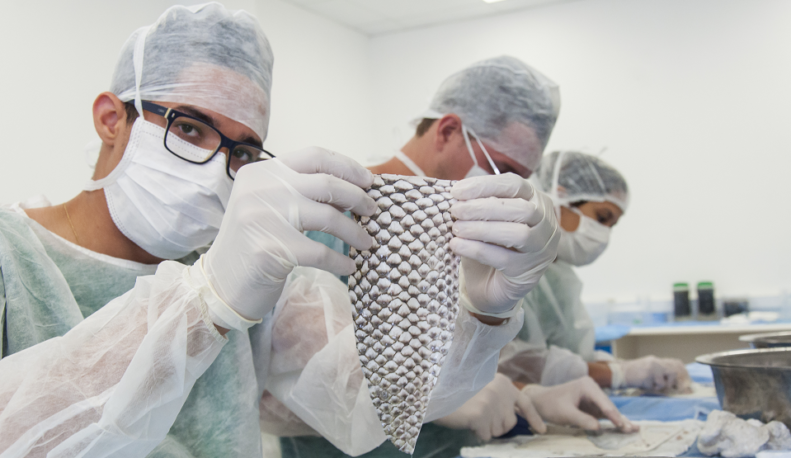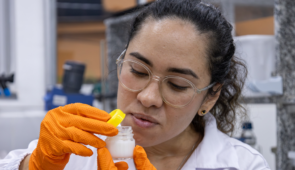Successful applications in the treatment of burn wounds, vaginal reconstruction procedures and gender confirmation surgery have made fish skin grafts increasingly popular worldwide. Recent studies funded by UFC found that tilapia skin is a valuable asset in fields as varied as dentistry, nutrition, and cosmetics, with laboratory trials already underway across thirteen other medical specialties.
Launched in 2015 by Dr. Edmar Maciel, from the Dr. José Frota Institute (IJF), in partnership with the UFC Drug Research and Development Center (NPDM), coordinated by Professor Odorico de Moraes, studies with tilapia skin have already led to the formulation of several products, such as glycerol-preserved skin (or glycerin), lyophilized skin (dehydrated), dermal matrix, and collagen extraction methods.
Glycerol-preserved skin has been applied in the treatment of burn injuries and in gynecological practices, and the lyophilized skin has been showing equivalent results for the aforementioned purposes, according to clinical studies that were launched three years ago. On the other hand, the dermal matrix and collagen extraction have opened up a wide range of possibilities for tilapia skin use.
The dermal matrix, also called scaffold, is a frame made of pure collagen, obtained through a long laboratory process of removing the fish cells. The elements of the wound healing process will flow through this material. Edmar Maciel has been the general coordinator of research involving tilapia skin since the beginning and he explains that this matrix was designed to be applied in internal body parts by different surgical specialties.

In dentistry, there are studies based in Ceará and in the state of São Paulo, in the city of Bauru. At the University of São Paulo (USP), for example, tilapia skin is being studied as a repairer and protector of the palate (roof of the mouth) after the removal of grafts, in order to protect the oral mucosa.
Regarding collagen extraction from the fish skin, studies are being developed in the cosmetology and nutrition fields as well. However, they are in the initial stages and searching for investments. For the former, the aim is to formulate cosmetics that can be used in all parts of the body. For the latter, Maciel explains that the expectation is for the development of a nutraceutical (products composed of nutrients, vitamins, minerals, and other food compounds) which would be made available in tablets or capsules to be orally tested.
According to the general coordinator, since the beginning of 2018, laboratory studies and animal research involving dermal matrix/scaffold have been carried out across 13 medical specialties, among which are: general surgery (abdominal hernia), plastic surgery (burn injuries and breast prostheses), cardiology (valves and vessels), gynecology (uterine and bladder prolapse surgery), neurology (replacing meningeal layers), urology (urethral reconstruction and Peyronie’s disease), otorhinolaryngology (perforated eardrum), endoscopy (esophageal fistula), ophthalmology (corneal lesions), among others.
The doctor explains that these medical procedures nowadays are performed in Brazil’s public healthcare system and other countries of the American continent with the use of imported products, which is expensive. The use of the abundant and low-cost tilapia skin may be a more cost-effective alternative that also provides several other clinical advantages.
Other studies, in initial stages, employ collagen extraction from the fish skin to make ointments and sprays that can treat burn injuries and wounds. Dr. Edmar Maciel also points out that the dehydration process of the tilapia skin, already developed, allows the product to be vacuum-packed and stored in room temperatures, facilitating logistics and guaranteeing a cost reduction in the skin transportation.
NPDM
Preclinical research on tilapia skin started at the UFC Drug Research and Development Center (NPDM), a highly relevant laboratory in the studies’ progress. “NPDM was very important for product development and for the initial discoveries, mainly that of the type I collagen presence in the tilapia skin, authored by Professor Ana Paula Negreiros and her team”, Edmar Maciel points out.
At UFC, the preclinical phase lasted for 18 months and it had 11 stages, including skin sterilization, toxicology and microbiology studies, and animal testing. The final sterilization process requires irradiation, which was carried out at the Nuclear Energy Research Institute (IPEN-SP), coordinated by Professor Mônica Mathor, through a research partnership. Only after all these processes did the skin start to be tested on humans, initially at IJF in 2016.
“The University and I have a commitment to go forward with this project, which can generate unimaginable benefits to society. This research is demanded by the people and there is a need for these products to reach Brazil’s public healthcare system. We will spare no effort to ensure its progress”, declares Edmar Maciel.
Source: Edmar Maciel, general coordinator of research on tilapia skin – email address: edmarmaciel@gmail.com
Translation: Isabelly Maia – Research Assistant at UFC’s Translation Laboratory (LETRARE/PROINTER)






